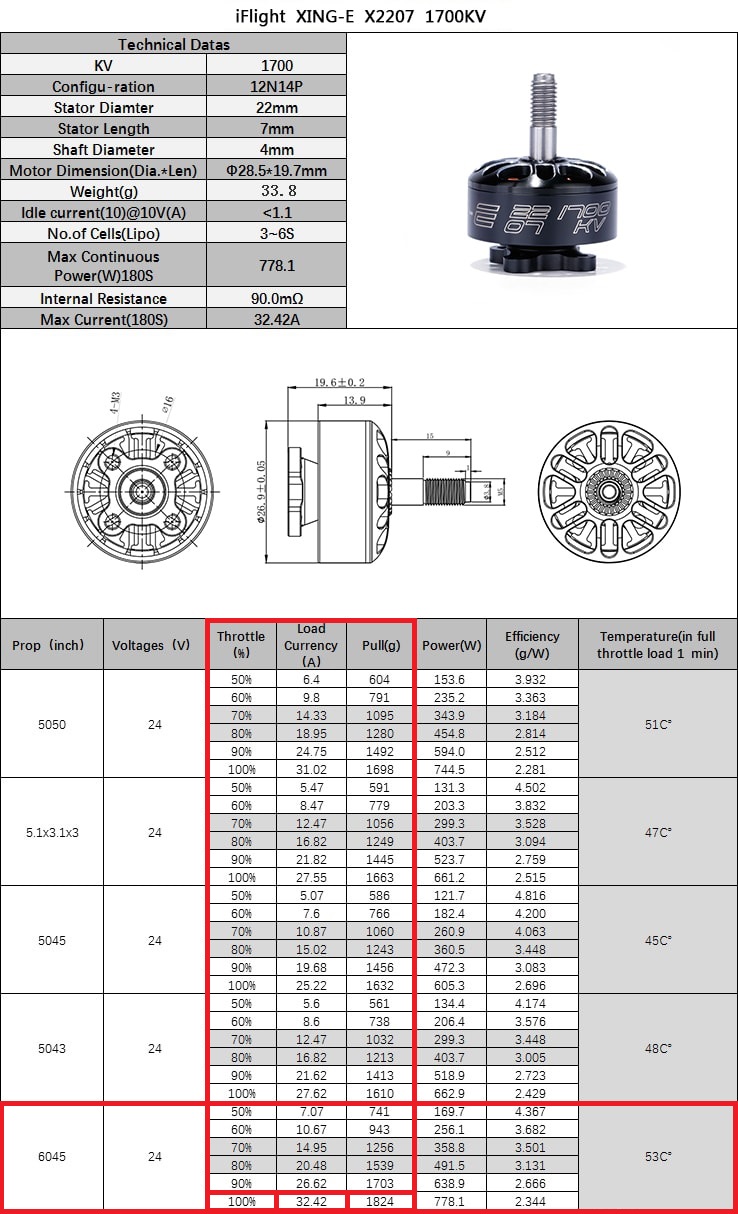
- 1 Introduction
- 2 Is a LiPo battery a safe power source?
- 3 Basic information about LiPo batteries for mini drones
- 3.1 Battery voltage and number of cells (S)
- 3.2 Capacity and size of LiPo battery
- 3.3 C-rating (Discharge rate)
- 3.4 C-rating of charge (Charge Rate))
- 4 Main battery connectors
- 4.1 Connectors for 1S battery
- 4.2 Connectors for 2S -6S battery
- 4.3 Balancing connector
- 4.4 LiHV
- 4.5 Internal resistance
- 5 How to choose the right LiPo battery for a quad?
- 5.1 Max. current consumption
- 5.2 Selecting the optimal battery capacity
- 5.3 Which brand to choose?
- 6 Charger selection
- 6.1 Recommended chargers
- 7 Charging modes
- 7.1 Parallel charging
- 8 Location and means for safe LiPo charging
- 8.1 General recommendations
- 8.2 Precautions when charging
- 8.3 Other notes on safe charging
- 9 LiPo guidelines
- 9.1 Voltage measurement
- 9.2 LiPo operating temperature range
- 9.3 When is the best time to end the flight?
- 9.4 How to store the battery correctly?
- 9.5 What to do with over-discharged batteries?
- 9.6 Traveling with LiPo battery
- 9.7 What to do if the battery catches fire?
- 10 LiPo disposal
- 10.1 When to dispose of?
- 10.2 How to dispose of?
- 11 Summarizing
- 12 FAQ
Disclaimer: All information on this page should be considered general advice / opinion. You are solely responsible for ensuring the safe operation of the battery. Further use of the information provided on this page will be at your own risk.
Introduction
FPV Drones / Racing Drones

Is a LiPo battery a safe source of power?
There are many reasons LiPo batteries can catch fire. As a rule, this happens only when their exploitation is not carried out properly, as a result of their physical damage, or due to marriage. If you buy batteries from trusted brands and use them carefully, then everything will be fine. However, we recommend that you read this manual carefully to learn how to properly handle Lithium Polymer batteries. Remember, safety comes first!
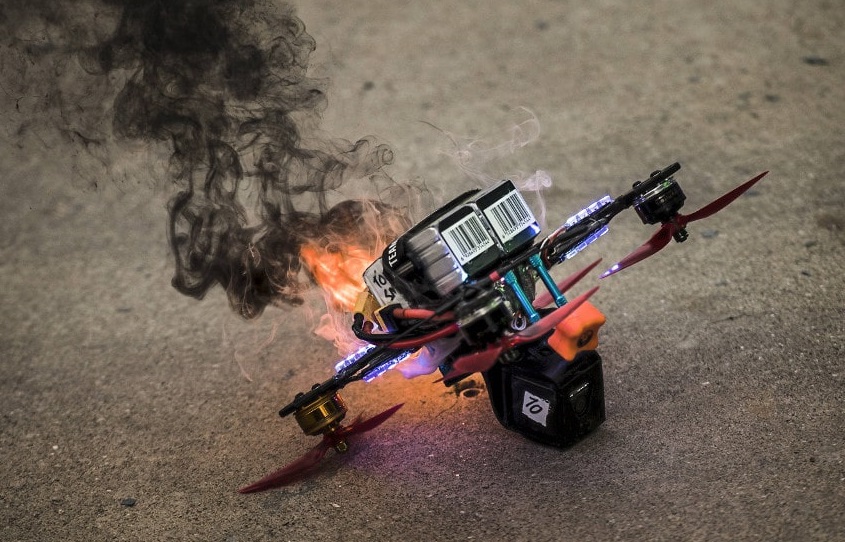
Basic information about LiPo batteries for mini drones
Lithium polymer batteries, better known as LiPo, have a high energy storage density, high discharge rate and light weight, making them an excellent candidate for powering RC models. Once you are familiar with the basics of LiPo batteries, you can easily read and most importantly understand their specifications.
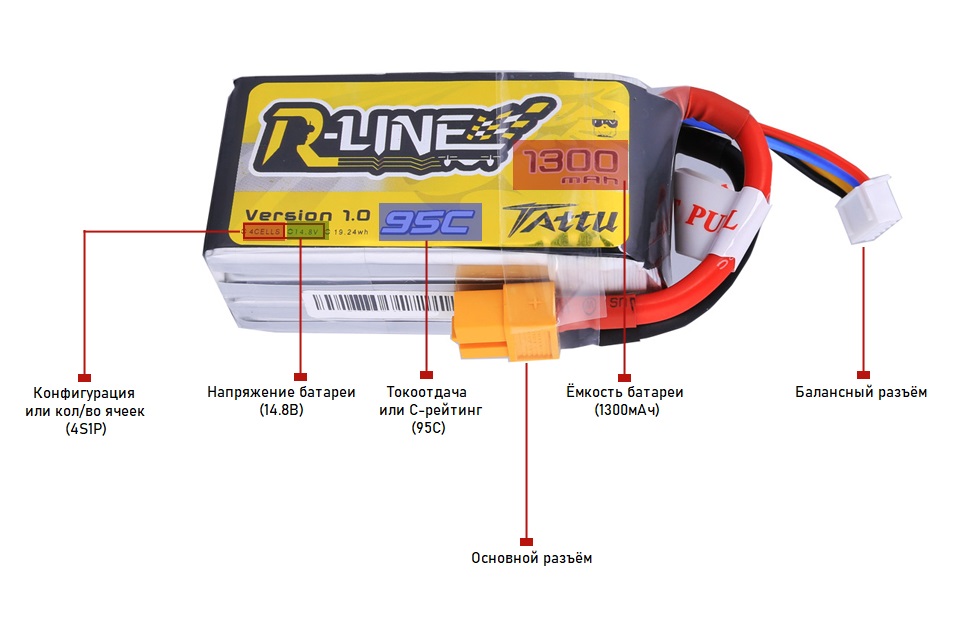
Battery voltage and number of cells (S)
LiPo batteries are composed of individual cells / cells / cell (s) (also denoted as "S"; in hobby they are called "banks"). Each LiPo cell / cell is rated at 3.7V. If a higher voltage is required, these cells can be connected in series to subsequently form one battery.
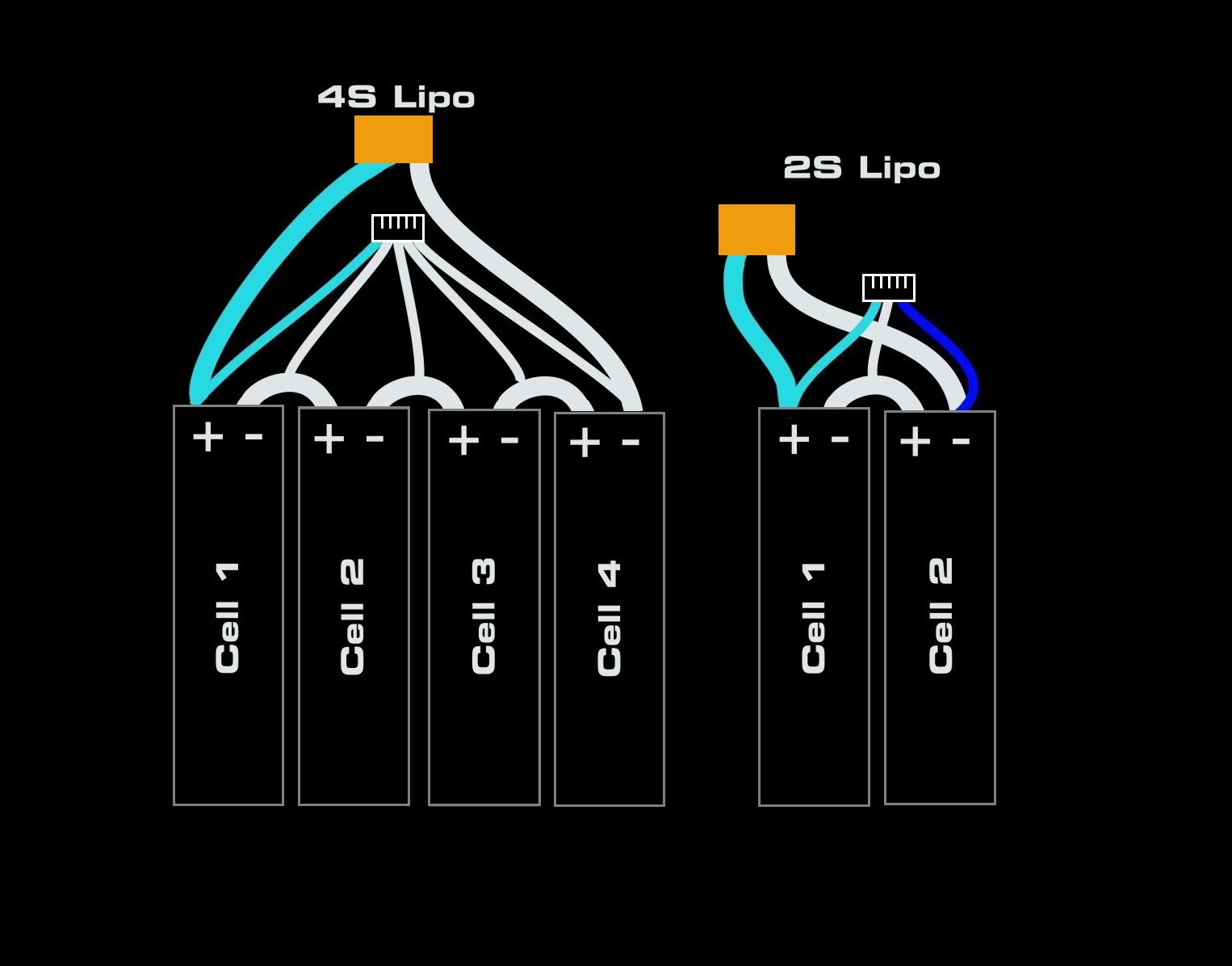
Usually, when mentioning a lithium-polymer battery, they refer not to the battery voltage, but to the number of cells (cells) in the battery or the number of "S":
- 1S = 1 cell = 3.7V
- 2S = 2 cells = 7.4V
- 3S = 3 cells (3-cell) = 11.1V
- 4S = 4 cells (4-cell battery) = 14.8V
- 5S = 5 cells (5-cell battery) = 18.5V
- 6S = 6 cells = 22.2V
For example: A 14.8V battery is called a "4-cell" or "4S" battery.

Information
- and other electronic components support higher voltage, then you can use batteries with more cells to significantly increase the speed potential of your quad.
- It should be understood that a battery with a large number of cans with the same capacity becomes heavier, since it contains more elements that make up the battery, and excess weight, as we already know, negatively affects the flight characteristics of the drone.
- To make a 4S 1000 mAh battery and gain some weight, you can simply daisy chain two 2S 1000 mAh or one 3S 1000 mAh with a 1S 1000 mAh.
- The nominal voltage of the LiPo batteries is 3.7V. This value has nothing to do with the voltage that the battery can give out while in a fully charged or discharged state. The rated voltage is set by the manufacturers of these batteries and is the optimal and safe value for each individual battery.
- The LiPo battery is designed to operate within a safe voltage range of 3 to 4.2V per cell. Discharge below 3V can result in irreversible loss of performance and even damage to the battery. Overcharging above 4.2V can be dangerous and eventually cause a fire. Despite this, it is recommended to stop working the battery when its voltage reaches 3.5V. For example, for 3S Lipo, the maximum voltage is 12.6V and you should land the drone when the voltage reaches 10.5V (i.e. at 3.5V per cell).
Capacity and size of the LiPo battery
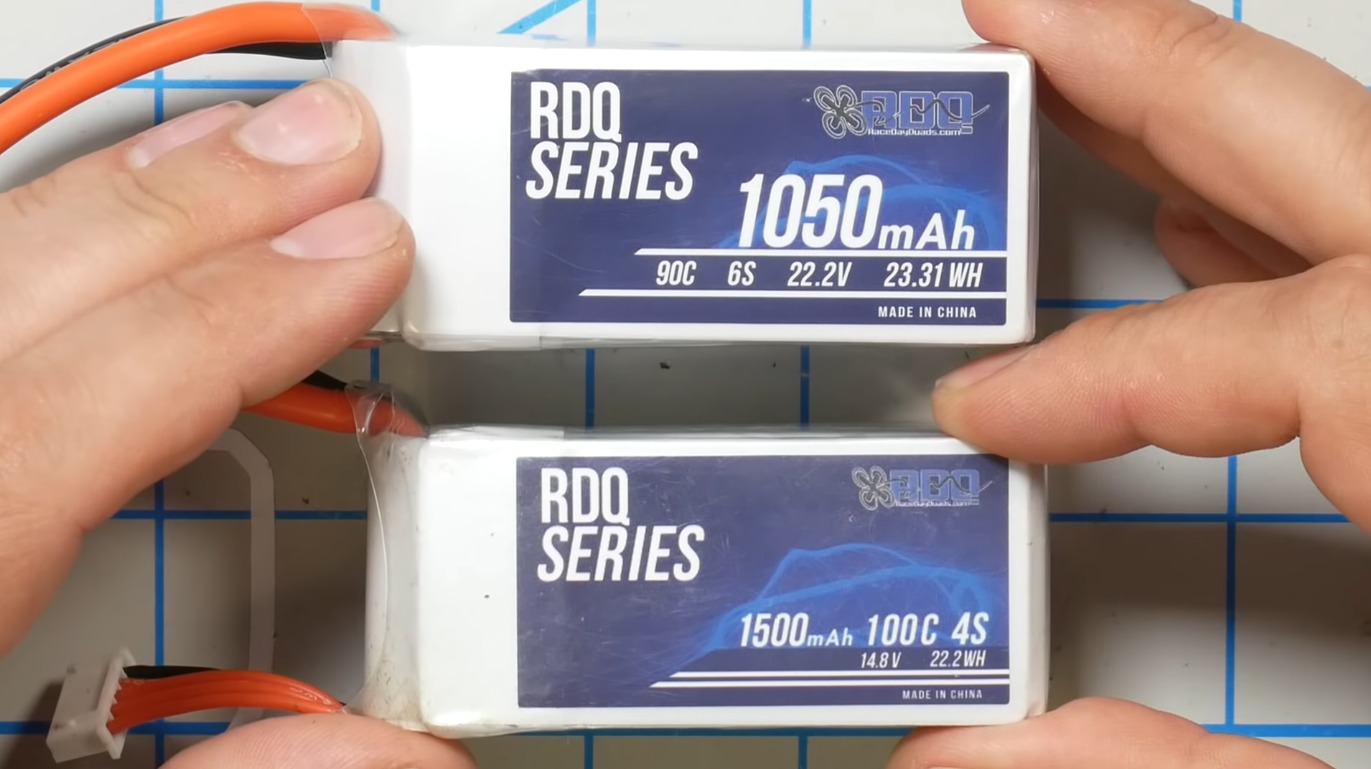
The capacity of the LiPo battery is measured in mAh / mAh (milliampere-hour / milli- amp hours). The "mAh" is essentially a measure of how much current you can draw from the battery in an hour before it runs out.
Example: For a 2000mAh Lipo battery, it will take an hour to fully discharge if you discharge it continuously at 2A. If the current consumption is doubled to 4A, the duration will be halved (2/4 = 0.5). If you increase the current consumption to 40A in non-stop mode, then it will take only 3 minutes for such a battery to fully discharge (2/40 = 1/20 hour).
Information
- An increase in battery capacity leads to an increase in flight time, but with an increase in capacity, the weight and physical dimensions of the battery also increase. In this case, it is necessary to find a compromise between power and weight, which in turn affects the flight time and maneuverability of the drone. Among other things, a higher capacitance predetermines a higher discharge current, which we will talk about in the next section.
Just in case, recall that 1000 mAh = 1Ah.
C-rating (Discharge rate)
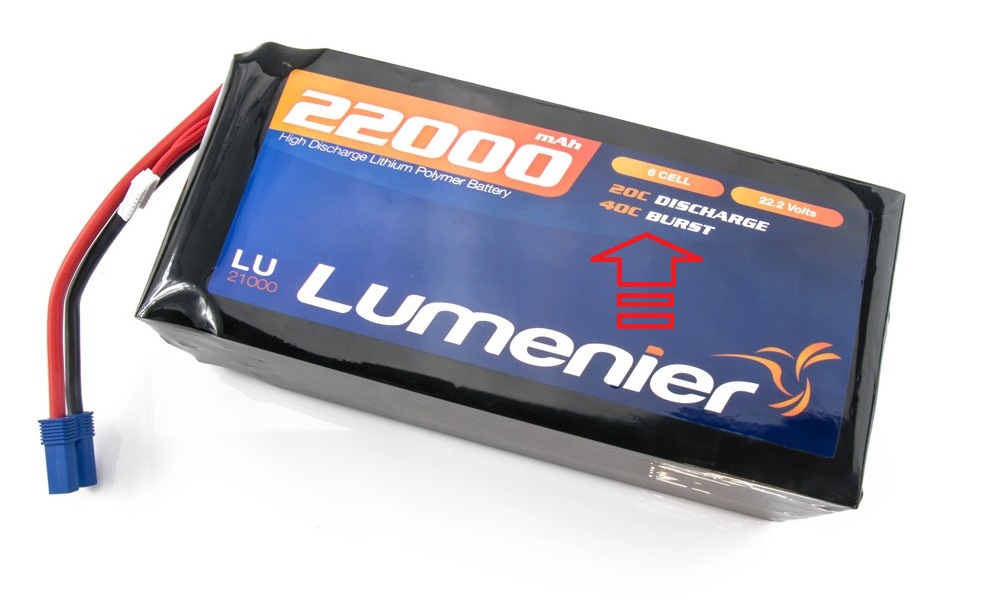
its specification is such an important parameter as C-Rating / Discharge Rate. Knowing the nominal value "C" and the capacity of the battery, we can calculate the theoretical safe continuous maximum discharge current of the LiPo battery:Max. discharge current = C-Rating × Capacity / 1000.
Example: Battery with characteristics: 2000 mAh 65C has a calculated max. continuous max discharge current - 130A.
Continuous and peak
Also on the lithium-polymer battery, two values of "C-Rating" can be displayed at once: "Continuous" and "Burst) ". The peak rating value (usually twice the continuous rating) indicates the max. the current that the battery can deliver in a short period of time (usually about 10 seconds).
Information
- Despite the fact that this parameter is one of the priority characteristics of the battery, nowadays it has become the main marketing tool, and often the values indicated on the battery are far from real values on practice. In this connection, it is recommended to buy batteries only from manufacturers recommended in the hobby!
- Too small value of C-rating will not allow the drone to reach its maximum flight potential and it will be less dynamic. And if the current exceeds the nominal value, then you can even damage the battery as a result.
- When the C-rating is higher than required, you will not get a significant improvement in performance. Instead, the battery will be heavier, again adversely affecting flight time.
Charge Rate C
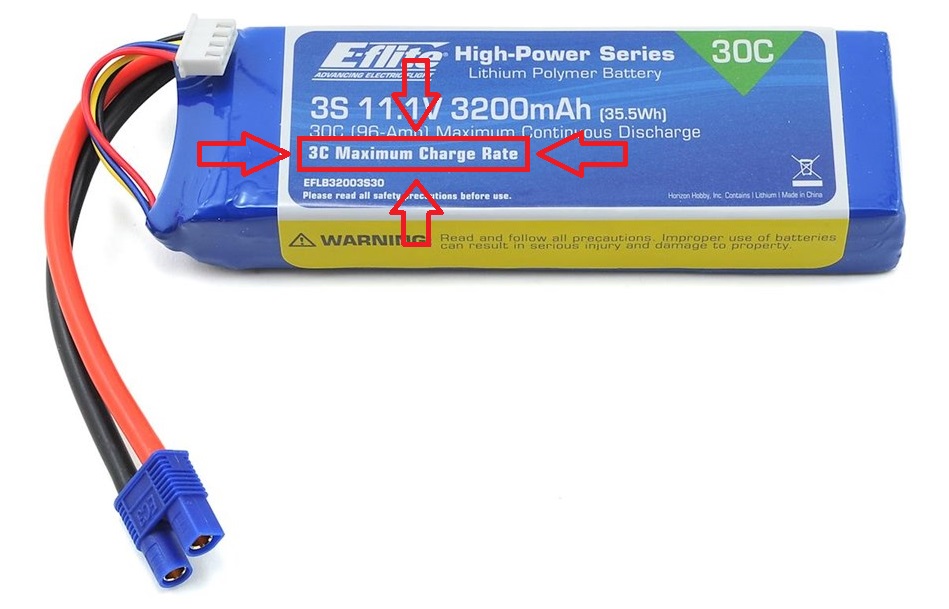
Charge Rate C / Charge Rate) Is another equally important parameter that can be displayed on the battery. Often, most rechargeable batteries are rated for a 1C charge rate. This value predetermines the maximum allowable amperage that can safely charge the battery. Calculate max. the possible charging current for a specific battery can be given by the formula:Capacity (mAh) / 1000 × "Charge Rate" = XX amperes. The charging current value is one of several preset charger settings before charging the battery.
For example: If you have a 2200 mAh LiPo battery with a 2C charge rating, then the maximum allowable charging current for it is 4.4A.
If you do not see the "Charge Rate" value on the front side of the battery, then perhaps it is mentioned on its back side.
For information
- Exceeding max. permissible value of the charging current will inevitably lead to a fire in the battery!
- The lower the amperage you charge, the longer the LiPo battery will take to charge.
- Slow charging will extend battery life. If you have time, take your time.
- If there is no “Charge Rate” value, don't risk it and charge it with a 1C rating.
Main battery connectors

Rule of thumb or rule of thumb: the battery connector must match the one used on drone. If you are building a drone from scratch, then choose the one that works best for you and stick to it throughout your hobby development. This approach will allow you to easily change batteries, and if you decide to build another drone in the future, you can use the same batteries.
All Lipo batteries have in their arsenal two sets of outgoing wires with different types of connectors / connectors at the ends of each: Balancing wire and Main or Discharge (except for 1S batteries
Connectors for 1S batteries

Connectors for 1S batteries are tiny and therefore rated for low amperage. Batteries with this type of connector are usually used to power micro quads, as well as for toy copters built on brushed motors.
- LOSI
- Pico blade
- JST-PH
- BT2.0
Connectors for 2S-6S batteries
You will find many more different types of connectors for this battery category. Not all of them are listed below, since most of the absent ones are not used very often in their hobbies, and you should not bother with them. For mini quads, the most popular was and remains the XT60 connector. But since the permissible current strength for this connector is no more than 60A, and the power potential of such drones is constantly growing, in the near future it will be replaced by other more powerful connectors.
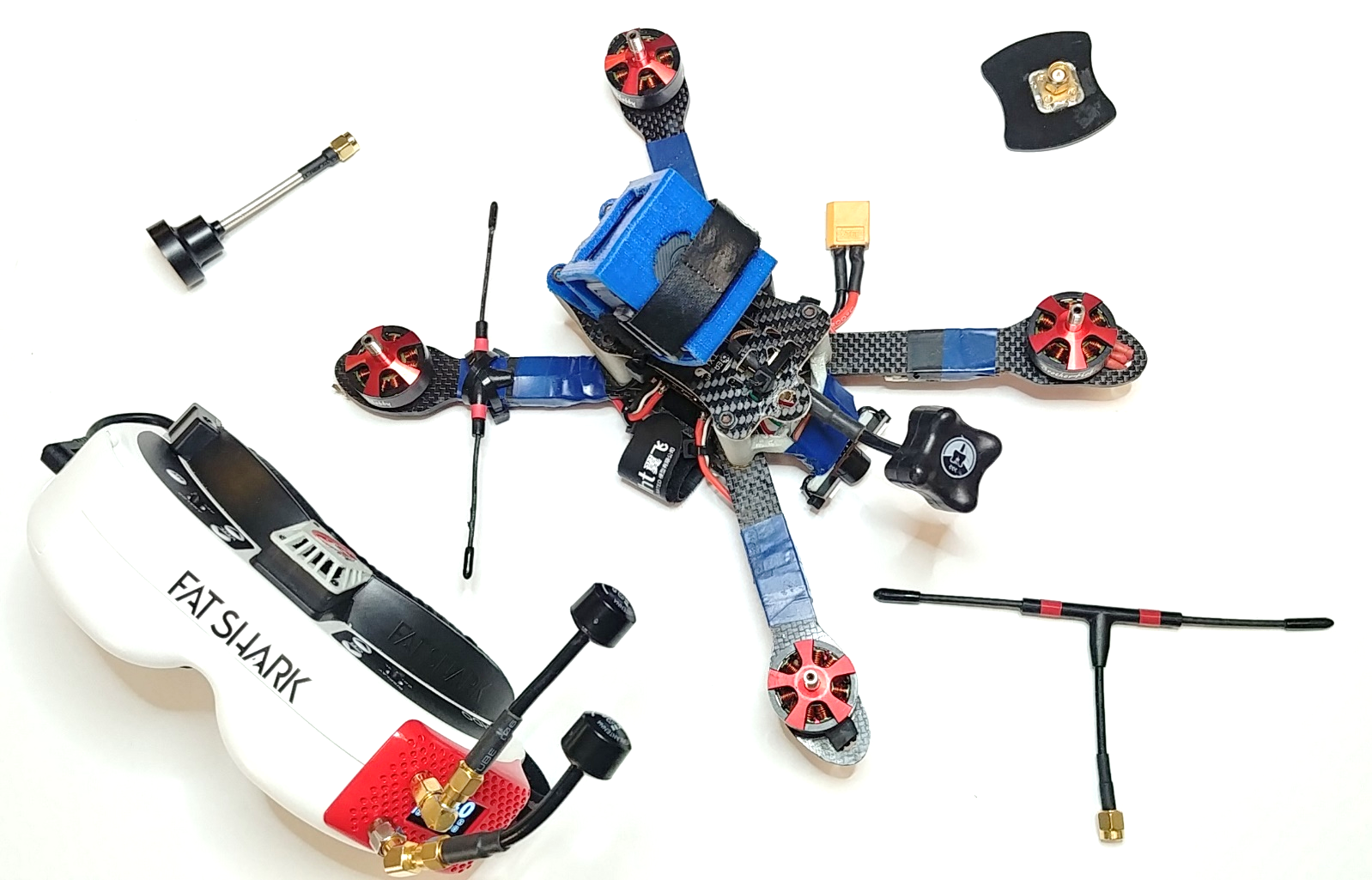
- JST
- XT30
- XT60
- XT90
- HXT-4mm
- EC3
- EC5
- Deans (T)
Balancing connector
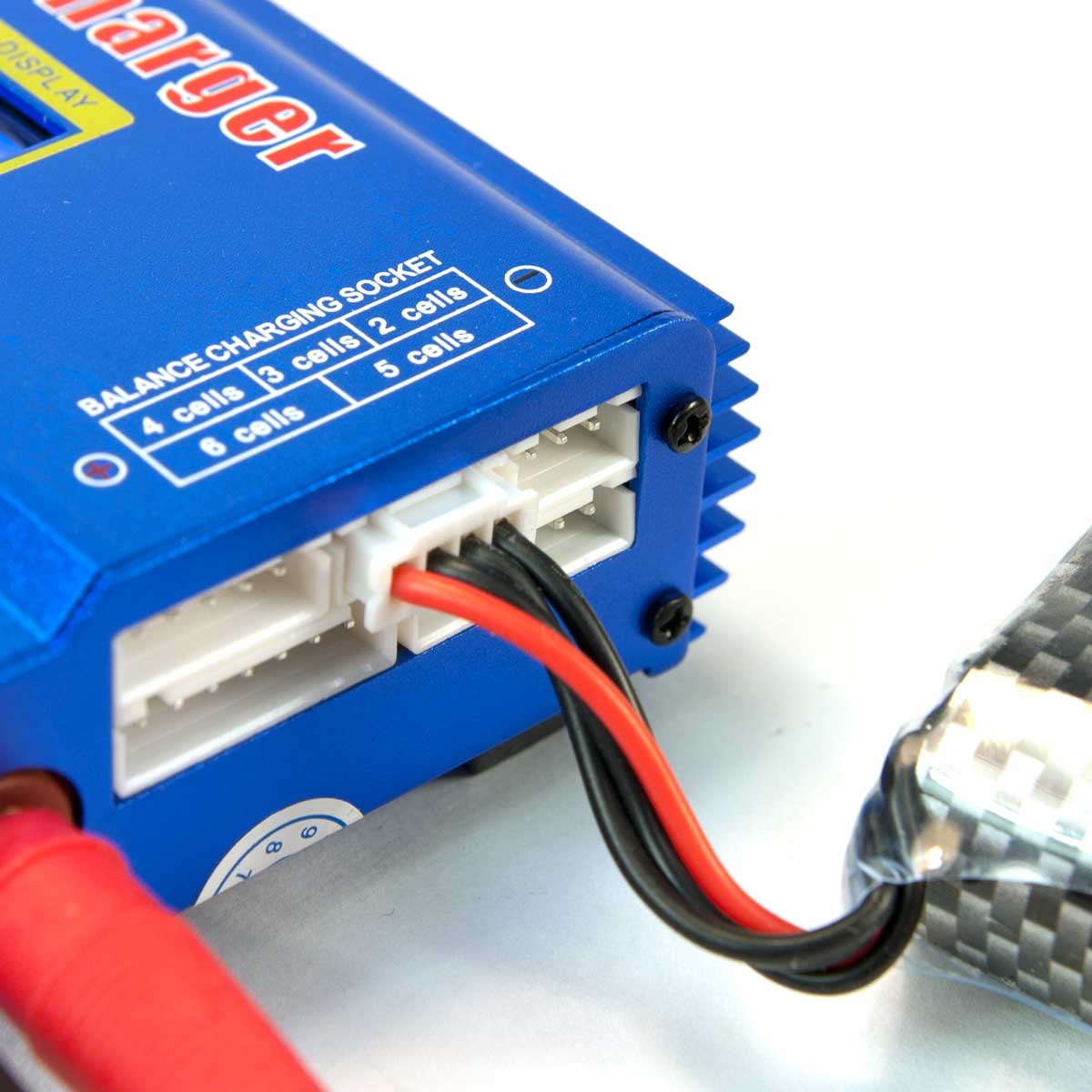
The balancing connector is mainly used for balanced charging of the battery. This charging ensures that each battery can be charged evenly. The number of wires for a balanced output depends on the number of battery cells, three wires have a 2S battery, four have a 3S and so on.
LiHV
LiHV (also known as LiPoHV / High Voltage Li-Po / LiPo HV) is a type of conventional lithium-polymer battery, where the abbreviation HV means High Voltage or High Voltage. Compared to conventional LiPo batteries, LiHV batteries have increased energy storage capacity and can be safely charged up to 4.35V per cell.
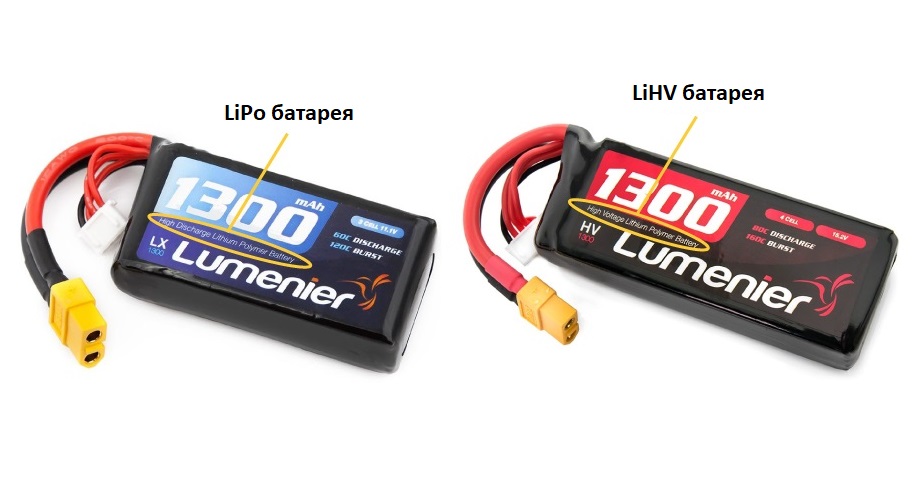
Advantages
In the list of LiHV battery advantages:
- With the same capacity, smaller and lighter
- Provide more dynamic radio-controlled model
- Longer operating time
- Less voltage drop at maximum operating modes
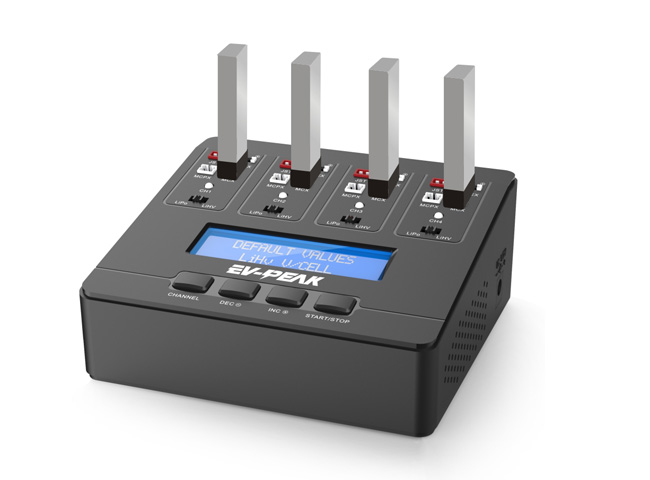
Information
- LiHV batteries are believed to have a shorter lifespan due to the increased performance.
- In practice, it has been found that compared to conventional LiPo, LiHV batteries do not give a noticeable increase in flight duration. However, things change when it comes to powering FPV goggles / helmets / control gear. Here, the advantage of LiHV in terms of operating time is obvious and indisputable.
- For LiHV charging, we recommend using chargers that support charging such batteries.
- It is not recommended to charge LiPo batteries together with LiHV batteries, as this can also lead to fire of ordinary LiPo batteries.
- It is strictly forbidden to charge ordinary LiPos up to 4.30V-4.35V in the hope of increasing their performance! Otherwise it will ignite the battery!
Internal Resistance
Internal Resistance (IR) determines the LiPo quality of the battery. The lower the value, the better. Higher internal resistance reduces the maximum current delivered by the LiPo and increases the voltage sag. As a result, most of the energy is wasted and released in the form of heat, which ultimately contributes to overheating of the battery.

Information
- The internal resistance of a LiPo battery increases during operation, and the process itself is inevitable and irreversible. That is why, over time, the batteries cease to give out their former potential, which in turn affects the dynamism of the drone's flight.
- The IR value will be different for each individual LiPo cell. The highest value will limit its effectiveness.
- A large variation between the values of each jar indicates its poor condition, and the smallest indicates a good one.
- You can measure the internal resistance both by means of special user tools - testers (for example: YR1035), and by means of some chargers with the function of measuring internal resistance (for example: ISDT Q6 Pro / Plus).
How to choose the right LiPo battery for your quad?
If you are choosing a battery for a serial quad model, then everything is simple. It is enough to look into the drone's specification and clarify the recommended battery parameters, by means of which to select the battery in the catalog of one of the well-known and hobby-tested battery developers, which we will talk about a little later. If the power is selected for a quadrocopter assembled from scratch, then the selection path will be slightly longer. The first step is to determine the basic power requirements for your assembly.

Max. current draw
Since battery selection is often the last step in building your own drone, we already know which motors, ESCs and propellers will be used in the assembly. Having familiarized yourself with the characteristics of the motors, in particular with the thrust data table (usually provided by the motor developer along with the specification), you can see how much current the motor consumes at max. thrust (at 100% gas).
For example: Propeller assembly group consists of: 4 × iFlight XING-E 2207 1700KV motors; with 6045 propellers. If we look at the thrust table provided by the motor designer (see specification below), we can see that the current consumption for the selected motor with 6 "prop at max. thrust is 32.42A. Knowing the value of the current consumed by one motor, we determine the max. consumed current for a quadrocopter:32.42А × 4 = 129.68А. In general, this figure can be used to select the optimal battery, but advanced users, due to the considerations noted below, reduce it by 10%, i.e.129.68 × 0.9 = 116.7A.
Considerations
- current, as a rule, is always lower than the value obtained with "static pull tests".
- Current at 90% gas and at 100% are fundamentally different values. In practice, the operating range of the throttle stick is 40-80%, and the 90-100% position is fixed for just a few seconds. From here the question is - how often will you fly in the "throttle to the floor" mode?
- In addition to the motors, power is consumed by other integral components of the drone, such as the flight controller (FC), receiver (RX), LED indication / lights, FPV, and so on. However, compared to motors, the voltage consumption of these components is extremely small, so advanced users simply ignore them in their calculations, or, on the contrary, add 1-2A if they allow the drone to be retrofitted with energy-intensive components in the future.
Selecting the optimal battery capacity
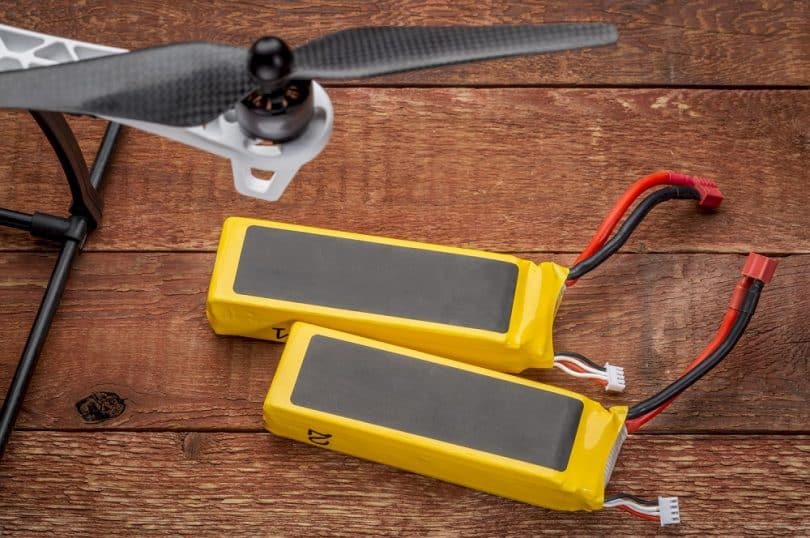
It is known that the size of the propeller determines the size of the drone frame used. And knowing the size of the drone and the required C-rating, you can determine the optimal battery capacity. Since most advanced users refer to the size of the drone by the size of the propeller, in the process of advancing in the hobby, a so-called pattern of selection based on the diameter of the propellers used was developed:
- For a quad on 6-inch propellers: 1500 mAh - 2200 mAh
- For quad on 5 "props: 1300 mAh - 1800 mAh
- For quad on 4" props: 850 mAh - 1300 mAh
- For quad on 3-inch props: 650 mAh - 1000 mAh
For example: Let's say you are building a 6-inch mini-quad and aim to make the assembly as easy as possible. In this case, it would be best to choose a battery with a capacity of 1500 mAh (1.5 Ah).
With all this data, you can calculate the value of the peak discharge current (C-Rating Burst) by the formula: C-Rating Burst = Max. consumed current / capacity. Returning to our example, we get:116.7A / 1.5Ah ≈ 78C. Typically, the "C Rating Continuous" value is half of the "C-Rating Burst" value, respectively:78/2 = 39C.
Information
- If you are building a drone for high-speed flights (throttle operating range is more than 50%), then it will be better to choose batteries with a large C- rating compared to the calculated one.
- Before making a choice of battery based on the results of the calculation, decide on the future style of piloting. Think about what will be a priority for you - dynamism or flight time. For example, for an athlete participating in drone racing, the speed / dynamics of flight is important, so they prefer the lightest batteries, the capacity of which will be enough for exactly one race. Freestylers, on the other hand, are less focused on dynamics, which allows them to use higher capacity batteries, thereby extending the overall flight time.
Which brand should you choose?

- Avoid "no-name" batteries and stick to popular hobbyist brands.
- It is not worth buying batteries from new brands, at least until the first stable positive reviews. Also, it is not uncommon for some new brands to offer good batteries for the first time, and after the products are recognized in the hobby, they begin to reduce the quality in order to max. attracting profits.
- The list of well-known and time-tested brands today includes: Tattu, Turnigy, Infinity, Dinogy, Luminier, GNB, URUAV, Acehe, XF Power, CNHL Ministar, RDQ series (if you are sure that this list someone is missing, let us know in the comments).
Choosing a charger
There are many different chargers on the market today and therefore, as in the case of choosing a battery, only time-tested brands offer the best and most reliable solutions such as: ProLead RC, SKYRC, EV-PEAK, Tenergy, ToolkitRC, HOBBYMATE, ISDT (if you are sure that someone is missing from this list, let us know in the comments).
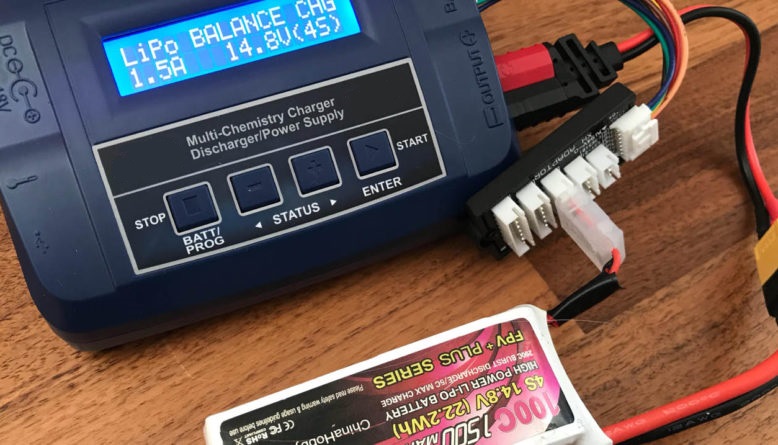
Recommended chargers
The batteries indicated in the list have positively proven themselves in the hobby, but these are not all models that could be recommend.
The complete set of chargers does not always include all the necessary adapters for charging the battery, but this is not a problem, since they can always be purchased. We've arranged all the models in order from simple to advanced (if you are sure that something is missing from this list, let us know in the comments).
- SKYRC B6 AC V2
- SKYRC IMAX B6 mini
- ProLead RC B6 80AC
- Tenergy TB6AC 80W
- SKYRC Q200
- EV-PEAK C1-XR
- ToolkitRC M8
- HOBBYMATE D6 DUO PRO
- ISDT D2 Dual
- ISDT Q6 Pro
- ISDT 608AC
- ISDT T8
The battery charging process for all devices is almost identical. We recommend watching this video about how this all happens.
Charging modes
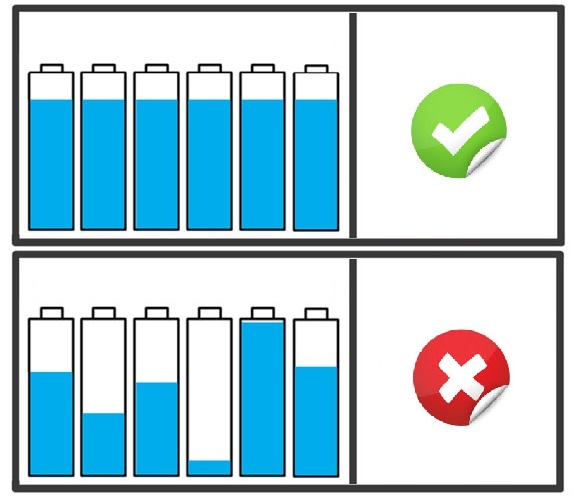
The main charging modes that are available for almost any modern charger:
- Direct charge / Fast charge - in this case, the battery is charged only through the main / discharge wire, which excludes the ability of the charger to control the voltage of each cell throughout the charger process. Typically, this charging option is faster than others, but once charging is complete, the actual voltage of each cell may be different and the 100% charge level will not be reached.
- Balance charge - in this case, the battery is connected to the charger through the main / discharge and balancing wires, which allows the charger to control the voltage of each cell and charge them separately, maintaining equal tension throughout the process. This is the safest and most recommended method of charging lithium polymer batteries, which, among other things, excludes both the moment of undercharging each cell and the most dangerous moment of overcharging.
- Charging to storage mode - in this case, the charger brings the voltage of each battery bank to 3.8-3.85V, which allows for careful storage of the battery on days when they are not in use... This approach is necessary because LiPo batteries cannot be stored in a fully charged state, or vice versa in a fully discharged state, as this adversely affects their internal resistance, which in turn determines their service life.
- Discharge - in this case, the charger will slowly discharge the battery (characterized by an extremely slow discharge process, even slower than charging).
Parallel charging
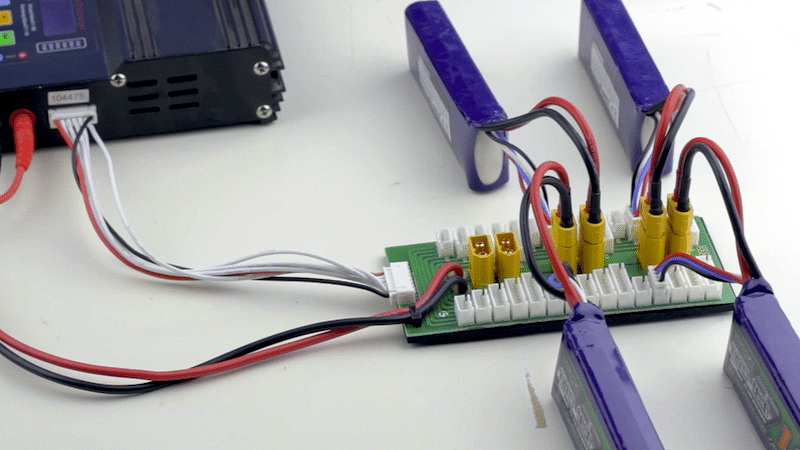
Parallel charging is not the safest way to charge LiPo batteries, but probably one of the The fastest ways for most radio controlled hobbyists are to get back to the sky. This approach allows you to charge several batteries at the same time in succession. However, it should be understood that you do this at your own peril and risk.
LiPo Safe Charging Location and Facilities
Choose and equip your battery charging location wisely! No matter how pessimistic the recommendations below may look, we recall that, by and large, the ignition of lithium-polymer batteries occurs only in cases of improper operation, or as a result of force majeure / marriage from which none of us is immune. Therefore, the more thoroughly you prepare for the possible risks associated with LiPo exploitation, the easier the consequences after they occur.
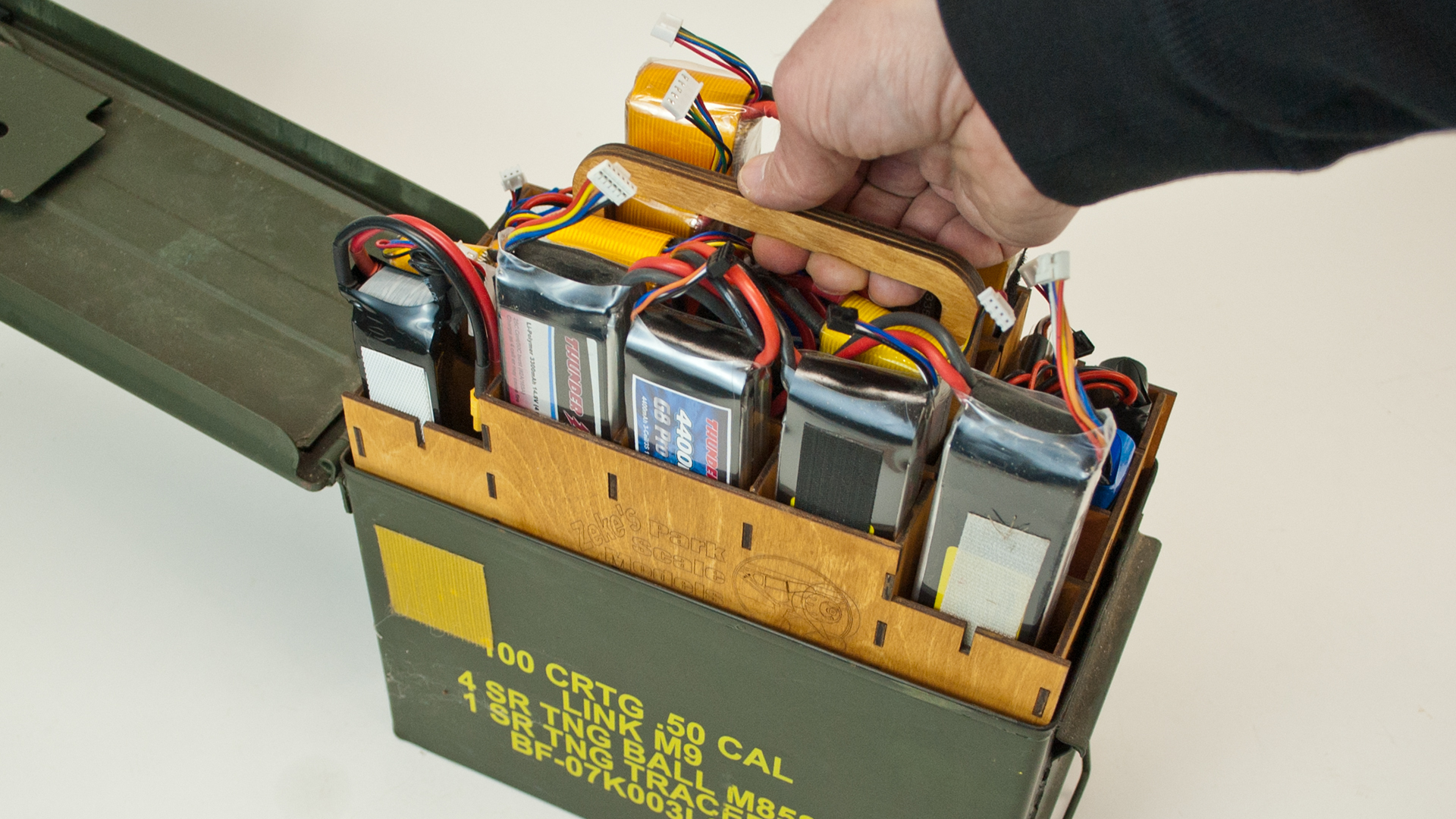
Basic recommendations
- Apartment / house is not the best place for charging and storing LiPo, but since this is the most a common option among ordinary users of RC hobbies, then you need to take care of purchasing special equipment, including fire-fighting equipment (see points below).
- It is very important to charge the batteries in an area free from flammable objects and materials.
- The best option is to re-equip / retrofit the premises in accordance with the fire hazard level (recommended).
- For charging / storing LiPo, it is recommended to make / use iron boxes or boxes (better with separate walls and it is good if there is sand between the walls). As a serially produced version, the simplest safe or well-proven and time-tested proprietary solutions sold under the brand “ Batt-Safe ” are excellent.
- Do not trust the often offered on the market - " LiPo Bags
- It will be useful at the place of charging to install an iron container with a lid half-filled with sand (the simplest example, a bucket, etc.). Firstly, sand acts as a simple and effective means for extinguishing / localizing the source of ignition (you can simply fill the battery with sand). Secondly, in the event of a fire, such inventory will allow you to safely localize the source of the ignition by placing the battery in the container with sand and then closing the lid, thereby completely eliminating the spread of fire in the room. To capture the already burning LiPo, you can use a pliers-type tool with extended handles.
- The presence of primary fire extinguishing equipment, such as a fire extinguisher, has also not been canceled. To extinguish lithium, only fire extinguishers with a powder composition LithX / Vexon-D3 (Based on graphite / Various fluxes and graphite with hydrophobic additives) or powder class D fire extinguishers are used. However, it should be noted that extinguishing with such compositions is more relevant for technical premises, since after use in an apartment / house, the powder may have a detrimental effect on both humans / animals and interior items, electronics, etc.
- Vapors of burning lithium are poisonous, which predetermines the purchase of such respiratory protection equipment as masks, half masks, respirators, gas masks.
An Exemplary Approach to Safety
Precautions for Charging
Watch your batteries carefully when charging:
- Never leave rechargeable batteries unattended, as a rule, all fires caused by a LiPo fire occurred precisely through the fault of the user's carelessness!
- During charging, regularly check whether the battery is heating up or starting to swell, and if so, stop charging immediately!
- A good LiPo battery will never heat up during the charging process. If this fact takes place, then it is necessary to immediately stop the process and find out the reasons for the heating.
Outcome of carelessness
Recent sad experience. As the author himself explains, he is far from a beginner, he simply loosened control over rechargeable LiPo batteries. Nobody was hurt as a result of the fire.
Other notes on safe charging
Mishandling LiPo batteries can cause a fire. Please take your time and read these safety guidelines before using / charging batteries.
- It is recommended to charge the battery with a current of 1C or less (see the section above “C-rating of charge”).
- Do not charge the battery immediately after use, wait until it has completely cooled down.
- Check the correspondence of the charger settings with the rechargeable battery (for example, check: the number of cans "S").
- Never use or charge a damaged battery - do not charge it if it is swollen or has other visible signs of damage.
- Be careful not to overcharge the battery. Despite the fact that the charger monitors and does not allow the fact of overcharging, it is recommended to regularly check the current battery voltage using a voltmeter.
- Disconnecting the battery from the charger should be done by directly grasping the connector / connector itself. In other words, it is not worth pulling the wires or the battery to disconnect, as this can lead to the separation of the supply / balancing wires from the connector / s at the soldering points, which can subsequently lead to a short circuit of the battery with subsequent fire.
- Do not leave the battery in direct sunlight.
Recommendations for LiPo operation
Voltage measurement
LiPo tester is a compact device that allows you to monitor the voltage of each LiPo cell batteries to be aware of the uniformity of their charge level. If one of the cells has too low or, on the contrary, high voltage, compared to the rest of the battery cells (what is called an imbalance in the RC hobby), then most likely this bank is experiencing problems, and you need to balance charging the battery before using it.
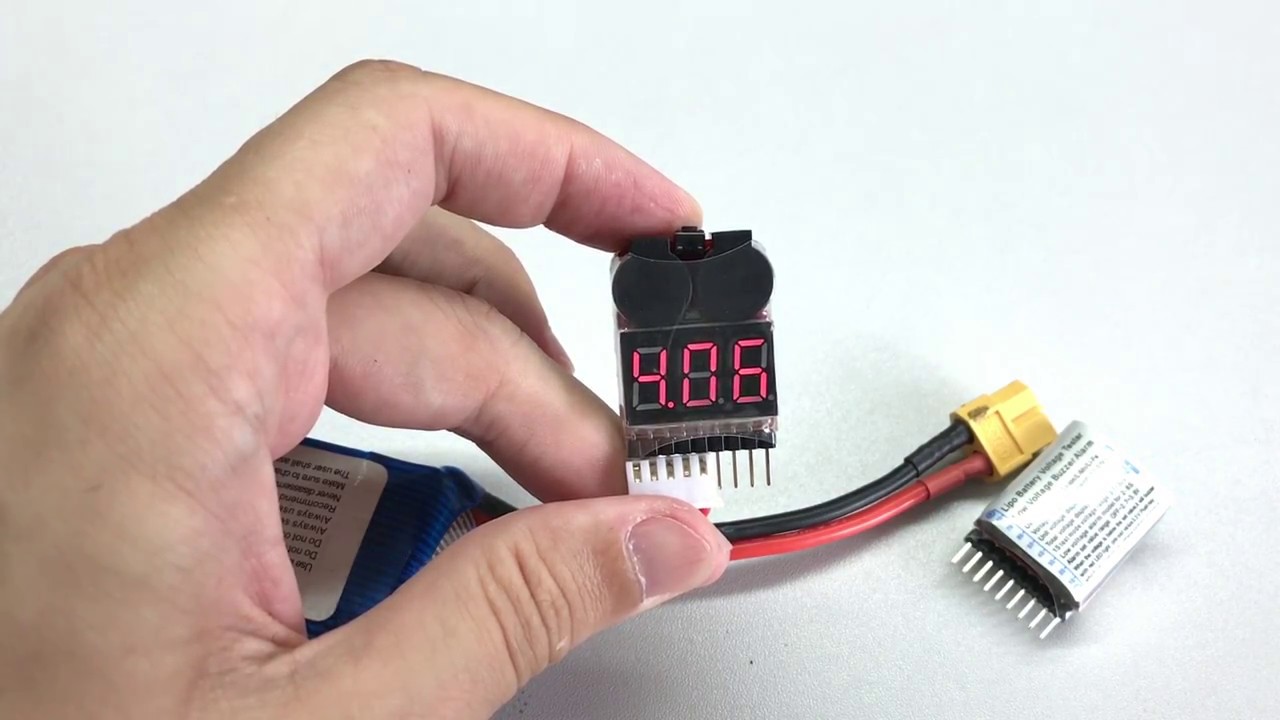
LiPo operating temperature range
- For mini-quads max. LiPo battery performance is achieved at temperatures between 25 ° C and 55 ° C.
- Cold weather significantly degrades the performance of LiPo batteries: the discharge rate and effective capacity are reduced (up to 40%). Common symptoms when using LiPo in freezing temperatures are: shorter flight times, loss of power / pickup, and severe voltage dips.
- For optimal performance, it is best if the battery is preheated to 30 ° C… 35 ° C prior to flight. To do this, just put the batteries in a warm place (a pocket for example) or you can resort to the so-called " Heated LiPo Protective Bag
- LiPo also doesn't like being too hot. Once the temperature of the battery reaches 60 ° C, it may swell and even catch fire.
When is the best time to end the flight?
This is one of the most common questions newbies ask: "When should I land?" Professionals recommend terminating the flight when the voltage for each battery cell reaches 3.5V to 3.6V. Lithium polymer batteries must not be discharged to zero, they must always have an acceptable charge level!
The graph below explains why. The fact is that the voltage in LiPo does not decrease linearly as the capacity is consumed, but drops sharply when it reaches about 3.5V - 3.6V for each LiPo cell. And if by this time you have not yet landed, then you run the risk of over-discharging the battery, and over-discharging the LiPo battery, in turn, can lead to irreversible damage to the battery and shorten its life.
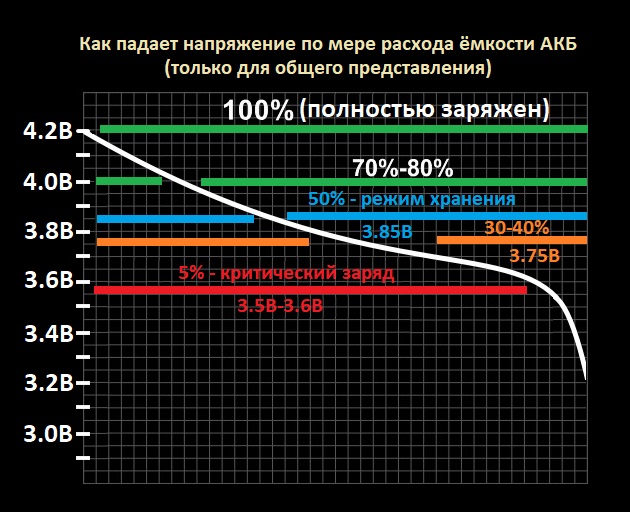
How to store the battery correctly?
If you decide not to use the LiPo battery for a long period of time (for example, longer than a week), you should:
- Charge the battery in “Storage charge” mode up to 3.8V - 3.85V.
- Cover all LiPo connectors with tape.
- Then put them in an iron box / box (mentioned above in “ Place and means for safely charging LiPo

Information
- When the LiPo cell is charged to 3.8V - 3.85V, the charge level is approximately 40-50%, which makes the lithium polymer battery the most stable state. This is why whenever you get a new battery from the store, it is only half charged.
- Storing LiPo in a fully charged state is not only unsafe, it also degrades performance.
- Do not use so-called safe LiPo bags or LiPo Safe Bag
What to do with over-discharged batteries?
From the moment the LiPo battery has been completely discharged, time begins to work against it, as oxidation processes start in each bank, which gradually and irreversibly begin to degrade the overall performance of the battery. Therefore, the sooner you connect it to the charger, the more likely it is to save the battery with minimal damage to its performance.
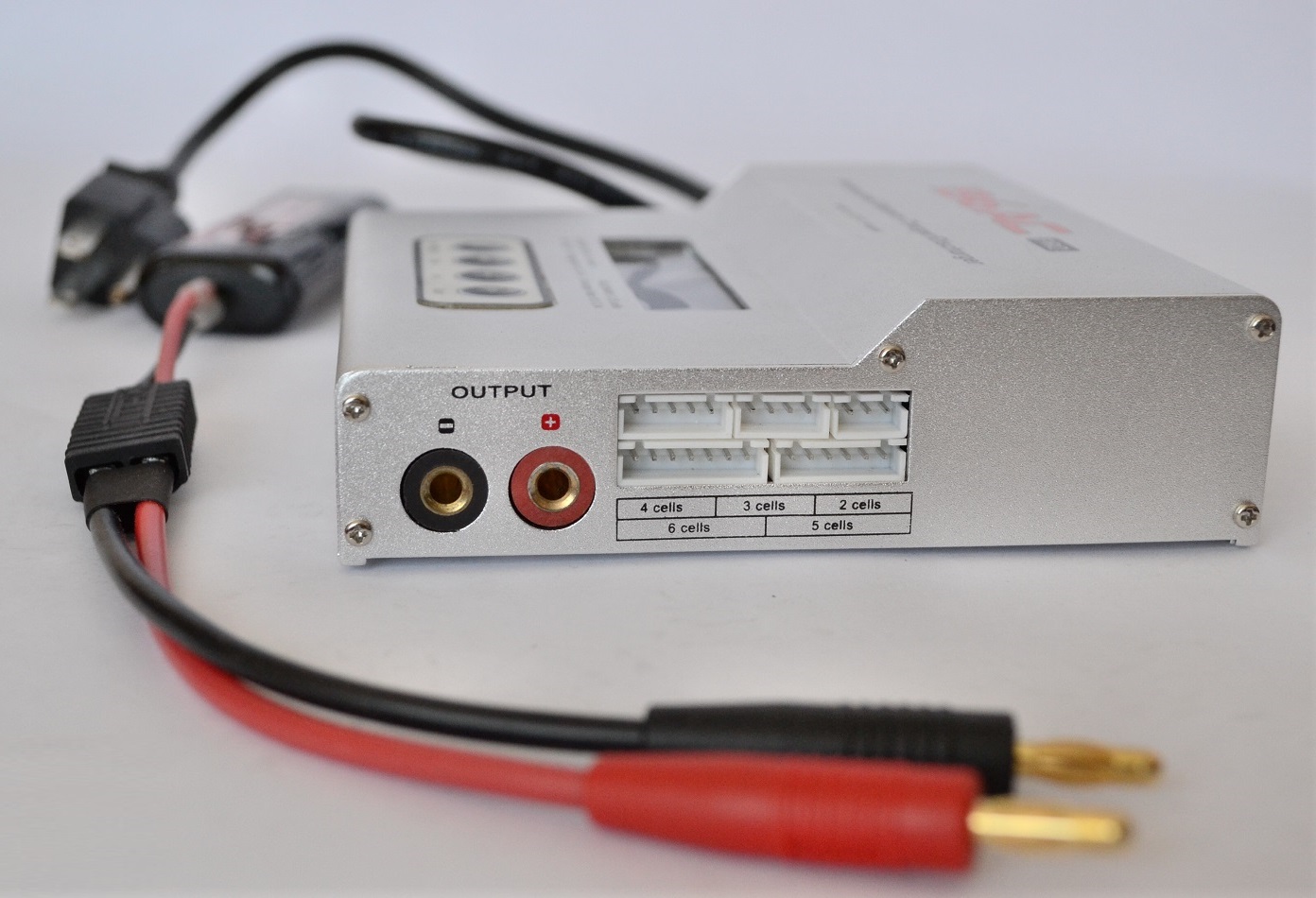
Chargers often refuse to charge an over-discharged battery. Despite the fact that there are "artisanal" methods of restoring such batteries (not safe), professionals recommend that you abandon their further use!
Traveling with LiPo batteries

Most airlines and airports allow the transport of LiPo batteries in the passenger's carry-on baggage. Here are a few tips to keep in mind:
- Check with the airline in advance about the possibility of transporting lithium polymer batteries.
- Do not leave batteries in your checked / checked baggage. Only carry-on baggage!
- Charge the battery to storage mode.
- Insulate all battery connectors / connectors with electrical tape and place them in an iron box.
- Never travel with swollen / damaged batteries!
What to do if the battery catches fire?
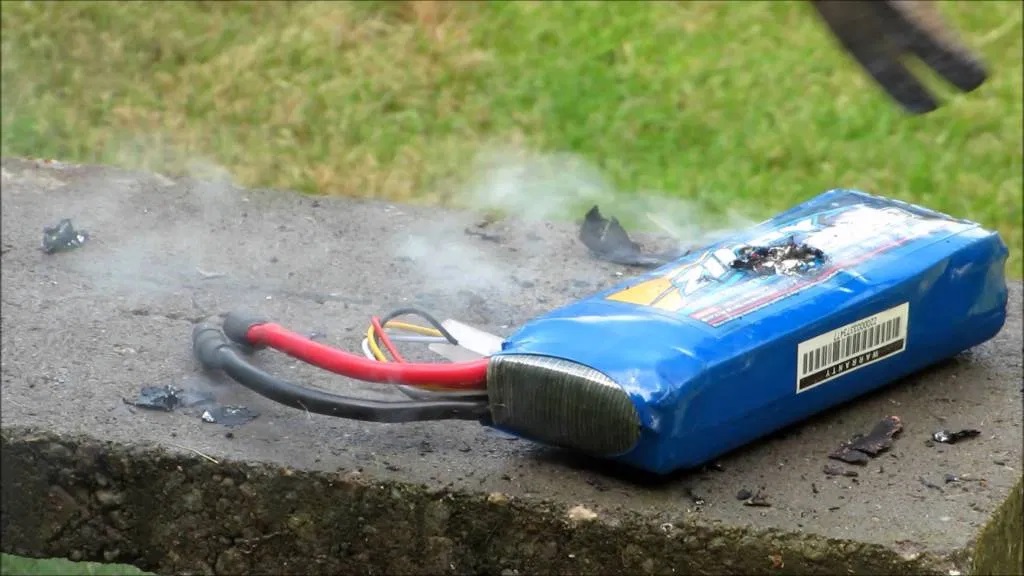
- Don't panic and unplug all connectors.
- Use sand as the easiest and most effective way to extinguish burning LiPo. Just cover the battery with sand. Or, as recommended above, immerse the LiPo in a specially prepared iron container with sand and cover with a lid.
- Wait until the fire goes out, the battery cools down and the smoke clears. Do not inhale the smoke, lithium fumes are poisonous!
- Do not use water to extinguish lithium-polymer batteries!
- Fire extinguishers only category "D"!
Recycling LiPo
LiPo batteries have a limited life due to the number of cycles. One cycle equals one charge followed by battery discharge. It is believed that, with proper use (as mentioned above), the batteries used to power radio-controlled LiPo models can withstand up to 300 cycles.

When to dispose of?
There are no specific rules about when you should stop using the battery. Professionals dispose of the battery as soon as it noticeably ceases to give out its former potential, when the drone's response to the movement of the gas stick becomes less acute, and the flight time is halved. Also, the weight of the argument indicating that it is time to dispose of the battery is its internal resistance, which inevitably grows during the operation of the battery (see the section above " Internal resistance
How to dispose of?
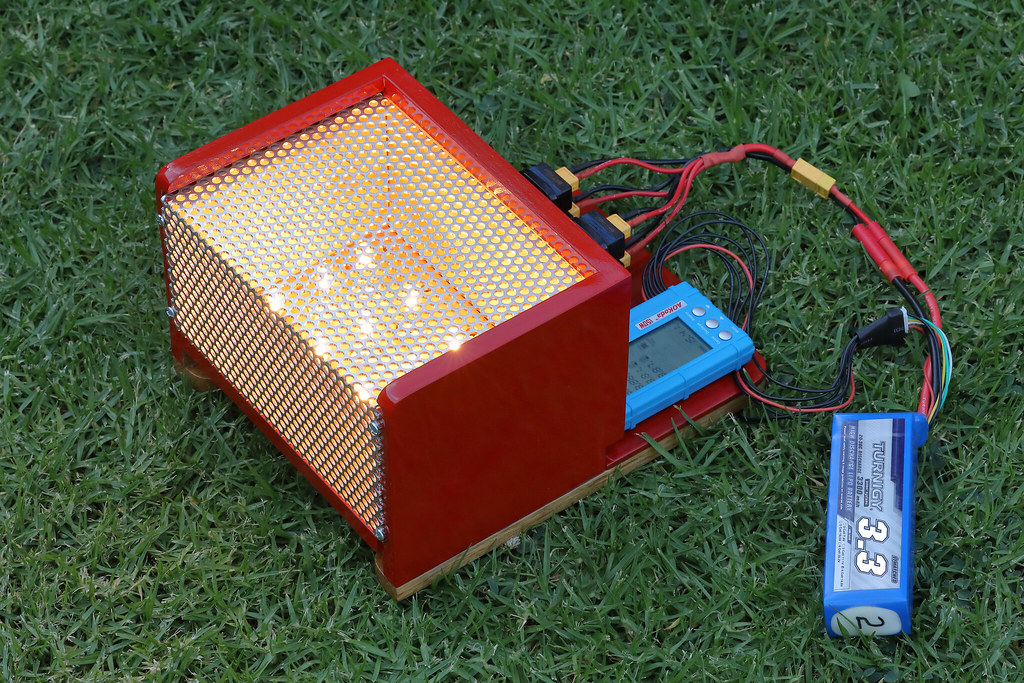
Before disposal, it is required to discharge the battery to a voltage value of 0V, which excludes the possibility of ignition of the battery even if its integrity is destroyed. After that, you need to hand over the battery to one of the available points for receiving used batteries. You can find out more about the collection points and the rules for the return of used batteries here.
Several safe discharge methods are mentioned in hobby circles:
- Discharging with a charger in “Discharge” mode (low current; example: at 1/10 C, a 3000mAh battery must be discharged with 0.3A or 3000/10 = 300mA). However, many chargers have overdischarge protection and can discharge batteries to a level not lower than 3V. If so, then consider discharging in the ways below. The discharge time by means of the charger is approximately one hour.
- Discharge with a small load (any current consumers; popular method with a light bulb or several at once, the best option is halogen lamps. LEDs are not suitable). You can also use any resistive load in place of a light bulb, such as a radial ceramic resistor. For example, for 2S or 3S Lipo, 150 ohm 2W resistors can be used. The discharge time for both methods is about an hour.
- By immersing LiPo in a water-salt solution until gassing stops. The composition of the solution: for 1 liter of water - 2-3 tbsp. tablespoons of salt. Many users claim that this method is slow and ineffective. You will need an unnecessary plastic container. The discharge time is about 2 weeks.
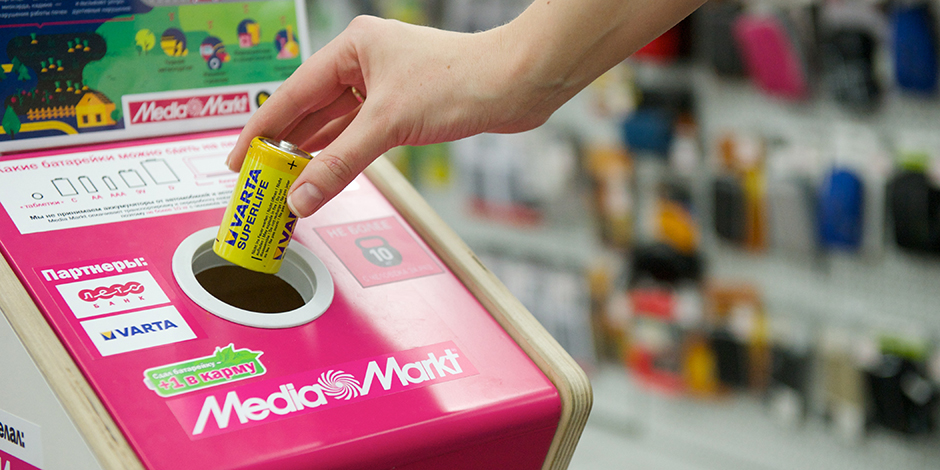
Let's summarize
, the safe operation and disposal of LiPo powered FPV drones, however, we do not claim that this is all you need to know about in this area. Summarizing all of the above, we note that at the current moment in time, lithium-polymer power supplies are the best that technologies can offer us, which, albeit slowly, continue to improve. You have nothing to worry about if you follow the basic rules of operation and do not allow carelessness from the moment of choosing and ending with the moment of disposal of the LiPo battery. We hope the material we have collected was useful to you. Thank you for your attention.
FAQ
Q. How dangerous are LiPos in use? A. No more than any other power source, subject to operating rules. Marriage also predetermines the level of safety for future use, therefore it is recommended to purchase batteries only from trusted brands. As the saying goes, "the miser pays twice."
Q. What brands does the RC community recommend? A. The list of well-known and time-tested brands for today includes: Tattu, Turnigy, Infinity, Dinogy, Luminier, GNB, URUAV, Acehe, XF Power, CNHL Ministar, RDQ series (if you are sure that this list is missing someone, let us know in the comments).
Q. Is a swollen battery dangerous? A. Definitely yes! Swollen batteries are not allowed for operation, are not repaired and are immediately rejected.
Q. What causes the battery to swell? A. Swelling of the battery causes uncontrolled gas escaping, and since each can is hermetically sealed, swelling occurs. There are several reasons for swelling: damage, overheating, excessive charging current / overcharging or excessive (high current) prolonged discharge, as well as a factory defect (typical for a “no-name” battery).
Q. How to avoid swelling of the battery? A. Do not overload the battery - use voltage alarms or monitoring for control; Do not overheat (do not leave batteries in the sun or near a heat source); Never recharge (correctly set the charger settings and keep an eye on the charger while charging; Store the LiPo correctly, as we mentioned in this article.
"Battery? A. The break-in procedure is a controversial topic in the FPV community. Basically, this practice requires new batteries to go through a series of slow cycles (charge and discharge) before being fully used. many professionals do not see any obvious difference with this approach.
Q. Other terminology affecting LiPo battery. A.
- Shutdown voltage (Cut-off voltage) - the voltage at which the battery is considered to be completely discharged; For LiPo, this threshold is set to 3V.
- Cycle life - One cycle includes charging and discharging the battery. Service life refers to the total number of such cycles during which the battery will operate.
- State of charge - current battery charge level from 0% to 100%.
- Burst C-Rating - The maximum discharge rate in a short amount of time (usually 10 seconds).
Q. What is the optimal voltage range for charging and discharging the battery? A. The LiPo battery is designed to operate within a safe voltage range of 3 to 4.2V per cell. Discharge below 3V can result in irreversible loss of performance and even damage to the battery. Overcharging above 4.2V can be dangerous and eventually cause a fire. Despite this, it is recommended to shut down the battery when its voltage reaches 3.5V. For example, for 3S Lipo, the maximum voltage is 12.6V, and you must land the drone when the voltage reaches 10.5V (i.e. at 3.5V per cell).
Q. What is the internal resistance of the battery? A. Internal Resistance (IR) determines the quality of the LiPo battery. The lower the value, the better. Higher internal resistance reduces the maximum current delivered by the LiPo and increases the voltage sag. The internal resistance of a LiPo battery increases during operation, and the process itself is inevitable and irreversible. That is why, over time, the batteries cease to give out their former potential. A large variation between the values of each jar indicates its poor condition, and the smallest one indicates a good one. Internal resistance is measured both by means of special tools - testers, and by means of some chargers.
Q. Which charger should I choose? A. There are many different chargers on the market, therefore, as is the case with the choice of batteries, only time-tested brands offer the best and most reliable solutions. Top brands list includes: ProLead RC, SKYRC, EV-PEAK, Tenergy, ToolkitRC, HOBBYMATE, ISDT (if you are sure there is someone missing from this list, let us know in the comments).
Q. What charging mode is best for LiPo charging? A. Balance charge - in this case, the charger monitors the voltage of each cell and charges them separately, maintaining the same voltage throughout the entire process. This is the safest and most recommended method of charging lithium polymer batteries, which, among other things, excludes both the moment of undercharging each cell and the most dangerous moment of overcharging.
Q. How safe is the parallel method of charging the battery? A. Despite the fact that parallel charging allows you to quickly and without problems simultaneously charge several batteries, significantly reducing the tedious waiting time, this method is still considered not safe. In this connection, parallel charging is most relevant exclusively in the field, where the possibility of burning expensive property is minimized.
Q. What is more reliable "LiPo Bags" or an iron box? A. Undoubtedly the advantage of iron boxes, as stated by numerous test reviews. Today, such products as "LiPo Bags" rarely cope with the task assigned to them, and even if they perform their functions, they are usually not suitable for subsequent use, which cannot be said about iron boxes, it is enough to clean and they are back in service.
Q. What is the operating temperature range of LiPo? A. For mini-quads max. LiPo battery performance is achieved at temperatures between 25 ° C and 55 ° C. Cold weather conditions noticeably degrade the performance of LiPo: the discharge rate and effective capacity are reduced (up to 40%). Common symptoms when using LiPo in freezing temperatures are shorter flight times, loss of power / pickup, and severe voltage dips. For optimal performance, it is advisable to warm up the battery to 30 ° C... 35 ° C before flight (for example, put the batteries in a pocket or resort to the so-called "Heated LiPo Protective Bag"). Also LiPo doesn't like it when it's too hot. Once the temperature of the battery reaches 60 ° C, it may swell and catch fire.
Q. When is the best time to stop flying? A. It is recommended to terminate the flight when the voltage reaches 3.5V to 3.6V per cell. This is due to the fact that the voltage in the LiPo does not decrease linearly as the capacity is consumed, but drops sharply when it reaches about 3.5V - 3.6V for each LiPo cell. And if by this time you have not yet landed, you run the risk of over-discharging the battery, and over-discharging the LiPo leads to irreversible damage to the battery and shorten its life.
Q. Where to take used LiPo batteries? A. Details about the points of acceptance and the rules of delivery can be found here.
.